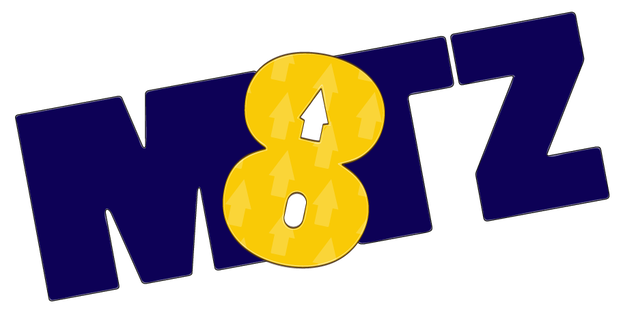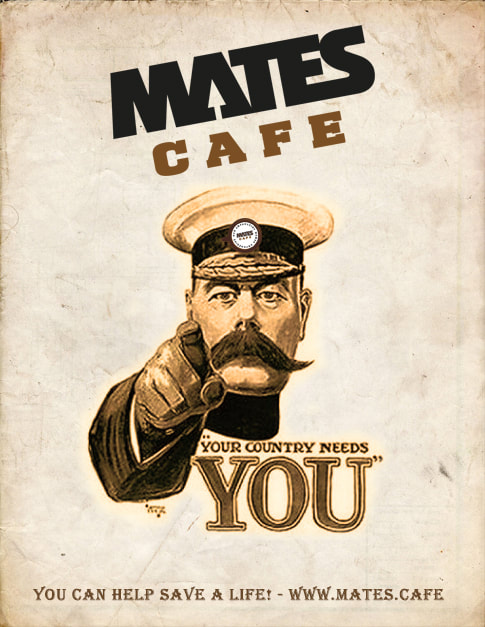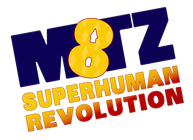You Are Not Alone - MATES Cafe Tauranga NZ
MATES Cafe is a network of everyday people of all cultures and ethnicity (including teens, elders and lgbt+) who are trained to meet with a person in crisis or isolation at a local cafe, and provide emotional support and encouragement.
MATES Cafe will empower your life so you can in turn empower the lives of others in need.
MATES are here:
To help people of all ages, gender, culture, ethnicity and personal beliefs through the challenges and tough times of life including relationship breakdown, depression, anxiety, loss and grief, bullying, loneliness and isolation. MATES are trained to be there for someone in need and helping them through a point of crisis in their life. It's not about therapy, fixing or giving advice, just simply listening and helping them to find new direction in their life.
Tauranga NZ - MATES Cafe Network
|
A Call-Out to ALL!
Can You Spare ONE Hour of Your Life to Save a Life? MATES Cafe is purely about saving lives. Do you realise one person completes suicide every 13 hours in New Zealand because they are unable to stand the emotional trauma they are undergoing, often caused by relationship breakdown. Every 4 minutes 1 New Zealander has suicidal thoughts and needs a MATE to turn to. MATES need your help to drastically lower the suicide rate... are you with us? Saving someones life can be to either:
|
Tauranga - Regional Centre
Tauranga (Māori pronunciation: [ˈtaʉɾaŋa])[2][3] is the most populous city in the Bay of Plenty region of the North Island of New Zealand.
It was settled by Māori late in the 13th century and by Europeans in the early 19th century and was constituted as a city in 1963.[4] Tauranga City is the centre of the sixth largest urban area in New Zealand, with an urban population of 123,500 (June 2013 estimate).[1]
The city lies in the north-western corner of the Bay of Plenty, on the south-eastern edge of Tauranga Harbour. The city expands over an area of 168 square kilometres (65 sq mi), and encompasses the communities of Bethlehem, on the south-western outskirts of the city; Greerton, on the southern outskirts of the city; Matua, west of the central city overlooking Tauranga Harbour; Maungatapu; Mount Maunganui, located north of the central city across the harbour facing the Bay of Plenty; Otumoetai; Papamoa, Tauranga's largest suburb, located on the Bay of Plenty; Tauranga City; Tauranga South; and Welcome Bay.
Tauranga is one of New Zealand's main centres for business, international trade, culture, fashion and horticultural science. The Port of Tauranga is New Zealand's largest port in terms of gross export tonnage and efficiency.[5][6]
Tauranga is one of New Zealand's fastest growing cities, with a 14 percent increase in population between the 2001 census and the 2006 census.[7] Though that number has slowed to 11% between the 2006 Census and the 2013 Census.[8] This sudden population growth has made Tauranga New Zealand's 5th largest city.
History Settlement The earliest known settlers were Māori who arrived at Tauranga in the Takitimu and the Mataatua waka in the 13th century. Europeans trading in flax were active in the Bay of Plenty during the 1830s; some were transient, others married local women and settled permanently. The first permanent trader was James Farrow, who travelled to Tauranga in 1829, obtaining flax fibre for Australian merchants in exchange for muskets and gunpowder. Farrow acquired a land area of 0.5 acres (2,000 m2) on 10 January 1838 at Otumoetai Pā from the chiefs Tupaea, Tangimoana and Te Omanu, the earliest authenticated land purchase in the Bay of Plenty.[9][dead link]
During the 1820s, Henry Williams travelled to Tauranga from the Bay of Islands to obtain supplies of potatoes, pigs and flax. In 1835 a Church Missionary Society mission station was established at Tauranga by William Wade; Rev. Alfred N. Brown arrived at the CMS mission station in 1838.[10]
In 1840, a Catholic mission station was established. Bishop Pompallier was given land within the palisades of Otumoetai Pā for a church and a presbytery. The mission station closed in 1863 due to land wars in the Waikato district.[11]
New Zealand Wars-Tauranga Campaign The Tauranga Campaign took place in and around Tauranga from 21 January to 21 June 1864, during the New Zealand Wars. The Battle of Gate Pa is the best known.[12]
The Battle of Gate Pa The battle of Gate Pā was the single most devastating defeat suffered by the British military in the whole of the Māori Wars. To contemporaries Gate Pā was seen as a shattering defeat. Indeed it was. The perception was that 1700 elite British troops had been defeated by 230 half naked savages.[12]
Modern era Under the Local Government (Tauranga City Council) Order 2003,[13][dead link] Tauranga became legally a city for a second time, from 1 March 2004.
In August 2011, Tauranga received "ultra fast" broadband as part of the New Zealand Government's rollout.[14] In December 2010, the Bay of Plenty's most expensive roading project began. The Tauranga Eastern Motorway(Also known as Tauranga Eastern Link and TEL) is a highway recognised by the government as a road of national significance, the Tauranga Eastern Link will be the Bay of Plenty’s largest roading project and a key strategic transport corridor for the region.[15] It will be open in 2016 and support the managed growth for the area; improve efficiency and contribute to economic development through improved travel time; provide a more direct route to the Port of Tauranga; provide a safer route between Tauranga and Paengaroa.[15] It will also provide safer and easier travel, reduced travel times between Tauranga and Paengaroa, more efficient connections for business, industry and tourism, support regional growth and generate jobs and a flow-on effect into the local economy in the form of wages and salaries.
Geography Tauranga is located around a large harbour that extends along the western Bay of Plenty, and is protected by Matakana Island and the extinct volcano of Mauao (Mount Maunganui). Ngamuwahine River is located 19 kilometres southwest of Tauranga.
Situated along a faultline, Tauranga and the Bay of Plenty experience infrequent seismic activity, and there are a few Volcanoes around the area (mainly dormant). The most notable of these are White Island and Mauao, nicknamed "The Mount" by locals.
Tauranga is roughly the antipode of Jaén, Spain.
Climate Tauranga has an oceanic or maritime temperate climate. Although it may be typical for tourism agencies to describe the climate as "subtropical", nowhere in the main islands of New Zealand actually meets the requirements for this.[16]
During the summer months the population swells as the holidaymakers descend on the city, especially along the popular white coastal surf beaches from Mount Maunganui to Papamoa.
Population Tauranga surpassed Dunedin in 2008 as the sixth largest city in New Zealand by urban area, and the ninth largest city by Territorial Authority area. The city was growing at a rate of 1.5% in 2008. Tauranga is set to surpass Dunedin in Territorial Area by the next Census in 2018.
In 1976, Tauranga was a medium-sized urban area, with a population of around 48,000, smaller than Napier or Invercargill. The completion of a harbour bridge in 1988 brought Tauranga and The Mount closer (they amalgamated in 1989) and promoted growth in both parts of the enlarged city. In 1996 Tauranga’s population was 82,092 and by 2006 it had reached 103,635.[18]
In 2006, 17.4% of the population was aged 65 or over, compared to 12.3% nationally. The city hosts five major head offices – Port of Tauranga, Zespri International, Ballance Agri-Nutrients Ltd, Trustpower and Craigs Investment Partners (formerly, ABN AMRO Craigs). Tauranga is home to a large number of migrants, especially from the UK, attracted to the area by its climate and quality of life.
Mount Maunganui Main Beach in winter, with 'Leisure Island' in the background. Economy Much of the countryside surrounding Tauranga is horticultural land, used to grow a wide range of fresh produce for both domestic consumption and export. There are many kiwifruit and avocados orchards as well as other crops. Recent years have seen the establishment of boutique vineyards and wineries.[citation needed]
The Port of Tauranga is New Zealand's largest export port, with brisk but seasonal shipping traffic. It is a regular stop for both container ships and luxury cruise liners.
Tauranga harbour. Picturesque sunrise over the Tauranga harbour. Tauranga's main shopping mall is Bayfair, in Mount Maunganui. Most of the city's shopping centres are located in the suburbs. They include Fraser Cove, Bethlehem Town Centre, Palm Beach Plaza, Fashion Island, Bayfair Shopping Centre, Bay Central and Greerton Village. In 2008 Tauranga's CBD underwent renovations to attract more shoppers to the inner city.[specify]
Arts and culture Religion A wide variety of faiths are practised, including Christianity, Islam, Buddhism, Hinduism, Sikhism and Judaism. There are many denominations of Christianity including Pentecostal, Methodist, Presbyterian, Roman Catholic, Baptist and Mormons.
Attractions Greater Tauranga is a very popular lifestyle and tourism destination. It features a natural attraction and some scenery. Cultural attractions include the Tauranga Art Gallery, which opened in October 2007 and showcases local, national and international exhibitions in a range of media.
Unique to Tauranga is Gyrate Flying Club where you can experience flying a modern gyroplane; the motorbike of the sky. [2]
View of Mount Beach, with Mauao in background The Te Puna Quarry park [www.quarrypark.org.nz/] has become a regional attraction and is fast becoming a popular tourist attraction.
Events The National Jazz Festival takes place in Tauranga every Easter, with dozens of live acts, great food and excellent wine.
New Year celebrations at the Mount in Mount Maunganui are one of Tauranga's main events, bringing people from all around the country.
Lifestyle The coastal suburb Papamoa and neighbouring town Mount Maunganui are some of the more affluent areas around Tauranga. The region’s beaches attract swimmers, surfers, kayakers and kitesurfers throughout the year.
Tauranga has many outlying islands and reefs that make it a notable tourist destination point for traveling scuba divers and marine enthusiasts.[citation needed] Extensive marine life diversity is available to scuba divers all year round. Water temperatures range from 12 degrees Celsius in winter to 22-24 degrees Celsius in summer. Tauranga houses two professional dive instructor training centers, training NAUI, PADI and SSI dive leader systems.
Sports McLaren Falls Park, on the outskirts of Tauranga Tauranga has a large stadium complex in the Bayfair suburb, Baypark Stadium, rebuilt in 2001 after a similar complex closed in 1995. It hosts Speedway events during summer and rugby matches in winter.
Tauranga is also the home of football (soccer) club Tauranga City United who compete in the Lotto Sport Italia NRFL Division 2.
Tauranga is the home to two rowing clubs - Tauranga Rowing Club in Memorial Park and Bay of Plenty Coast Rowing Club at the picturesque Wairoa River. Both clubs have had successful NZ representation over the years.
Parks and recreation Tauranga has many parks. One of the largest is Memorial Park, and others include, Yatton Park, Kulim Park, Fergusson Park and the large Tauranga Domain.
Due to the temperate climate, outdoor activities are very popular, including golf, tramping (hiking), mountain biking and white water rafting. The Bay of Plenty coastline has miles of golden sandy beaches, and watersports are very popular, including swimming, surfing, fishing, diving, kayaking and kitesurfing. Tourists also enjoy dolphin-watching on specially run boat trips.
Education Main article: List of schools in Bay of Plenty, New Zealand#Tauranga City Tauranga is home to the Bay of Plenty Tertiary Education Partnership, made up of Te Whare Wānanga o Awanuiārangi the Bay of Plenty Polytechnic and the University of Waikato. Tauranga and the Partnership are planning a University campus of its own. Stage 1 is expected to be open in 2017, catering for 500 but with capacity for 700, which will cost $67.3 Million.[19]http://www.boptertiarypartnership.ac.nz/boprc-funding.html
The main state secondary schools include:
There is also a Rudolf Steiner School in Welcome Bay, catering for birth to 12 year olds.
Transportation Tauranga railway bridge Main transportation in the city is provided by the Bay Hopper Bus. Tauranga Airport provides daily domestic flights to Auckland, Wellington and Christchurch Airports on Air New Zealand turbo-prop aircraft. Tauranga is located on the East Coast Main Trunk Railway.
It was settled by Māori late in the 13th century and by Europeans in the early 19th century and was constituted as a city in 1963.[4] Tauranga City is the centre of the sixth largest urban area in New Zealand, with an urban population of 123,500 (June 2013 estimate).[1]
The city lies in the north-western corner of the Bay of Plenty, on the south-eastern edge of Tauranga Harbour. The city expands over an area of 168 square kilometres (65 sq mi), and encompasses the communities of Bethlehem, on the south-western outskirts of the city; Greerton, on the southern outskirts of the city; Matua, west of the central city overlooking Tauranga Harbour; Maungatapu; Mount Maunganui, located north of the central city across the harbour facing the Bay of Plenty; Otumoetai; Papamoa, Tauranga's largest suburb, located on the Bay of Plenty; Tauranga City; Tauranga South; and Welcome Bay.
Tauranga is one of New Zealand's main centres for business, international trade, culture, fashion and horticultural science. The Port of Tauranga is New Zealand's largest port in terms of gross export tonnage and efficiency.[5][6]
Tauranga is one of New Zealand's fastest growing cities, with a 14 percent increase in population between the 2001 census and the 2006 census.[7] Though that number has slowed to 11% between the 2006 Census and the 2013 Census.[8] This sudden population growth has made Tauranga New Zealand's 5th largest city.
History Settlement The earliest known settlers were Māori who arrived at Tauranga in the Takitimu and the Mataatua waka in the 13th century. Europeans trading in flax were active in the Bay of Plenty during the 1830s; some were transient, others married local women and settled permanently. The first permanent trader was James Farrow, who travelled to Tauranga in 1829, obtaining flax fibre for Australian merchants in exchange for muskets and gunpowder. Farrow acquired a land area of 0.5 acres (2,000 m2) on 10 January 1838 at Otumoetai Pā from the chiefs Tupaea, Tangimoana and Te Omanu, the earliest authenticated land purchase in the Bay of Plenty.[9][dead link]
During the 1820s, Henry Williams travelled to Tauranga from the Bay of Islands to obtain supplies of potatoes, pigs and flax. In 1835 a Church Missionary Society mission station was established at Tauranga by William Wade; Rev. Alfred N. Brown arrived at the CMS mission station in 1838.[10]
In 1840, a Catholic mission station was established. Bishop Pompallier was given land within the palisades of Otumoetai Pā for a church and a presbytery. The mission station closed in 1863 due to land wars in the Waikato district.[11]
New Zealand Wars-Tauranga Campaign The Tauranga Campaign took place in and around Tauranga from 21 January to 21 June 1864, during the New Zealand Wars. The Battle of Gate Pa is the best known.[12]
The Battle of Gate Pa The battle of Gate Pā was the single most devastating defeat suffered by the British military in the whole of the Māori Wars. To contemporaries Gate Pā was seen as a shattering defeat. Indeed it was. The perception was that 1700 elite British troops had been defeated by 230 half naked savages.[12]
Modern era Under the Local Government (Tauranga City Council) Order 2003,[13][dead link] Tauranga became legally a city for a second time, from 1 March 2004.
In August 2011, Tauranga received "ultra fast" broadband as part of the New Zealand Government's rollout.[14] In December 2010, the Bay of Plenty's most expensive roading project began. The Tauranga Eastern Motorway(Also known as Tauranga Eastern Link and TEL) is a highway recognised by the government as a road of national significance, the Tauranga Eastern Link will be the Bay of Plenty’s largest roading project and a key strategic transport corridor for the region.[15] It will be open in 2016 and support the managed growth for the area; improve efficiency and contribute to economic development through improved travel time; provide a more direct route to the Port of Tauranga; provide a safer route between Tauranga and Paengaroa.[15] It will also provide safer and easier travel, reduced travel times between Tauranga and Paengaroa, more efficient connections for business, industry and tourism, support regional growth and generate jobs and a flow-on effect into the local economy in the form of wages and salaries.
Geography Tauranga is located around a large harbour that extends along the western Bay of Plenty, and is protected by Matakana Island and the extinct volcano of Mauao (Mount Maunganui). Ngamuwahine River is located 19 kilometres southwest of Tauranga.
Situated along a faultline, Tauranga and the Bay of Plenty experience infrequent seismic activity, and there are a few Volcanoes around the area (mainly dormant). The most notable of these are White Island and Mauao, nicknamed "The Mount" by locals.
Tauranga is roughly the antipode of Jaén, Spain.
Climate Tauranga has an oceanic or maritime temperate climate. Although it may be typical for tourism agencies to describe the climate as "subtropical", nowhere in the main islands of New Zealand actually meets the requirements for this.[16]
During the summer months the population swells as the holidaymakers descend on the city, especially along the popular white coastal surf beaches from Mount Maunganui to Papamoa.
Population Tauranga surpassed Dunedin in 2008 as the sixth largest city in New Zealand by urban area, and the ninth largest city by Territorial Authority area. The city was growing at a rate of 1.5% in 2008. Tauranga is set to surpass Dunedin in Territorial Area by the next Census in 2018.
In 1976, Tauranga was a medium-sized urban area, with a population of around 48,000, smaller than Napier or Invercargill. The completion of a harbour bridge in 1988 brought Tauranga and The Mount closer (they amalgamated in 1989) and promoted growth in both parts of the enlarged city. In 1996 Tauranga’s population was 82,092 and by 2006 it had reached 103,635.[18]
In 2006, 17.4% of the population was aged 65 or over, compared to 12.3% nationally. The city hosts five major head offices – Port of Tauranga, Zespri International, Ballance Agri-Nutrients Ltd, Trustpower and Craigs Investment Partners (formerly, ABN AMRO Craigs). Tauranga is home to a large number of migrants, especially from the UK, attracted to the area by its climate and quality of life.
Mount Maunganui Main Beach in winter, with 'Leisure Island' in the background. Economy Much of the countryside surrounding Tauranga is horticultural land, used to grow a wide range of fresh produce for both domestic consumption and export. There are many kiwifruit and avocados orchards as well as other crops. Recent years have seen the establishment of boutique vineyards and wineries.[citation needed]
The Port of Tauranga is New Zealand's largest export port, with brisk but seasonal shipping traffic. It is a regular stop for both container ships and luxury cruise liners.
Tauranga harbour. Picturesque sunrise over the Tauranga harbour. Tauranga's main shopping mall is Bayfair, in Mount Maunganui. Most of the city's shopping centres are located in the suburbs. They include Fraser Cove, Bethlehem Town Centre, Palm Beach Plaza, Fashion Island, Bayfair Shopping Centre, Bay Central and Greerton Village. In 2008 Tauranga's CBD underwent renovations to attract more shoppers to the inner city.[specify]
Arts and culture Religion A wide variety of faiths are practised, including Christianity, Islam, Buddhism, Hinduism, Sikhism and Judaism. There are many denominations of Christianity including Pentecostal, Methodist, Presbyterian, Roman Catholic, Baptist and Mormons.
Attractions Greater Tauranga is a very popular lifestyle and tourism destination. It features a natural attraction and some scenery. Cultural attractions include the Tauranga Art Gallery, which opened in October 2007 and showcases local, national and international exhibitions in a range of media.
Unique to Tauranga is Gyrate Flying Club where you can experience flying a modern gyroplane; the motorbike of the sky. [2]
View of Mount Beach, with Mauao in background The Te Puna Quarry park [www.quarrypark.org.nz/] has become a regional attraction and is fast becoming a popular tourist attraction.
Events The National Jazz Festival takes place in Tauranga every Easter, with dozens of live acts, great food and excellent wine.
New Year celebrations at the Mount in Mount Maunganui are one of Tauranga's main events, bringing people from all around the country.
Lifestyle The coastal suburb Papamoa and neighbouring town Mount Maunganui are some of the more affluent areas around Tauranga. The region’s beaches attract swimmers, surfers, kayakers and kitesurfers throughout the year.
Tauranga has many outlying islands and reefs that make it a notable tourist destination point for traveling scuba divers and marine enthusiasts.[citation needed] Extensive marine life diversity is available to scuba divers all year round. Water temperatures range from 12 degrees Celsius in winter to 22-24 degrees Celsius in summer. Tauranga houses two professional dive instructor training centers, training NAUI, PADI and SSI dive leader systems.
Sports McLaren Falls Park, on the outskirts of Tauranga Tauranga has a large stadium complex in the Bayfair suburb, Baypark Stadium, rebuilt in 2001 after a similar complex closed in 1995. It hosts Speedway events during summer and rugby matches in winter.
Tauranga is also the home of football (soccer) club Tauranga City United who compete in the Lotto Sport Italia NRFL Division 2.
Tauranga is the home to two rowing clubs - Tauranga Rowing Club in Memorial Park and Bay of Plenty Coast Rowing Club at the picturesque Wairoa River. Both clubs have had successful NZ representation over the years.
Parks and recreation Tauranga has many parks. One of the largest is Memorial Park, and others include, Yatton Park, Kulim Park, Fergusson Park and the large Tauranga Domain.
Due to the temperate climate, outdoor activities are very popular, including golf, tramping (hiking), mountain biking and white water rafting. The Bay of Plenty coastline has miles of golden sandy beaches, and watersports are very popular, including swimming, surfing, fishing, diving, kayaking and kitesurfing. Tourists also enjoy dolphin-watching on specially run boat trips.
Education Main article: List of schools in Bay of Plenty, New Zealand#Tauranga City Tauranga is home to the Bay of Plenty Tertiary Education Partnership, made up of Te Whare Wānanga o Awanuiārangi the Bay of Plenty Polytechnic and the University of Waikato. Tauranga and the Partnership are planning a University campus of its own. Stage 1 is expected to be open in 2017, catering for 500 but with capacity for 700, which will cost $67.3 Million.[19]http://www.boptertiarypartnership.ac.nz/boprc-funding.html
The main state secondary schools include:
- Papamoa College, co-educational secondary school opened in 2011 for years 7 - 13.
- Aquinas College a co-educational state-integrated Catholic school founded in 2003 for years 7 - 13, with around 800 pupils.
- Tauranga Boys' College, with about 1850 boys.
- Tauranga Girls' College, with over 1500 girls.
- Otumoetai College, with around 1900 pupils.
- Bethlehem Campus, a Christian educational institution for kindergarten, primary and secondary level students, with around 1500 students.
- Mount Maunganui College, a co-educational secondary school, with over 1500 students.
There is also a Rudolf Steiner School in Welcome Bay, catering for birth to 12 year olds.
Transportation Tauranga railway bridge Main transportation in the city is provided by the Bay Hopper Bus. Tauranga Airport provides daily domestic flights to Auckland, Wellington and Christchurch Airports on Air New Zealand turbo-prop aircraft. Tauranga is located on the East Coast Main Trunk Railway.
Realizing our full human potential... Imagine what we can achieve together!
M8TZ - Recreating Community: Worldwide | New Zealand | Australia | United States | United Kingdom | China | Canada | India
Refer Someone | Consultations | Contact M8TZ Cafe: | Policies | © MATES 2023 All rights reserved.
Refer Someone | Consultations | Contact M8TZ Cafe: | Policies | © MATES 2023 All rights reserved.




